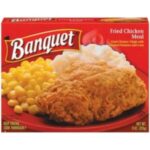Casseroles make excellent dinners. Made with the right ingredients, they can be a balanced meal complete with the essential food groups. They are an all-in-one meal and typically only require one dish for mixing ingredients and one dish for baking. Perhaps the best aspect of casseroles is that they freeze well. You can’t beat heating and serving a frozen casserole for a quick, easy, but wholesome meal. If you’ve never frozen these classic comfort dishes before, you might not know how. Follow these tips to stock your freezer with homemade meals that are ready in a flash.
Casseroles should always be baked before freezing. The first key to freezing baked casseroles is to line your baking dish with aluminum foil. Completely line the inside of the dish with foil and use a big enough piece so that it hangs over the edges of the dish. After your casserole has been cooked, let it cool for about 10 minutes on the counter, and then move it to the refrigerator to cool some more. Once cooled in the fridge so that the dish is no longer hot to the touch, move the casserole, dish and all, to the freezer. Now you only want to let your casserole freeze for a couple of hours. At this time, you will be able to easily lift your entire casserole out of the dish using the edges of the foil liner. Once you are able to lift it out completely, wrap the entire casserole completely in foil and label and date it. Next, place your foil wrapped casserole in the freezer for full freezing. Now you have your casserole in the freezer and you didn’t even dirty up a baking dish.
When reheating your casserole, simply drop the foil wrapped casserole back into a baking dish. Reheat your casserole at the oven temperature specified when you first baked it. The reheating time may be a little longer than the original cooking time, to fully heat your casserole. Check the dish often to see if it is heated through. There is rarely a need to thaw a casserole before reheating it. If you do wish to thaw, however, do so safely in the refrigerator.
If your casserole has pasta or rice in it, you may need to add a little liquid (water, broth, or milk depending on the type of casserole) because those foods tend to be a little dry after having been frozen. If your casserole has a topping, such as crushed crackers or bread crumbs, leave the topping off when you bake the dish the first time. Just add it during the last 10 minutes or so of reheating. Crackers and other toppings will get too soggy if frozen.
An easy way to prepare a casserole for freezing is to make two of the same casseroles at one time. Serve one of the dishes for dinner that evening, and freeze the other one. All you have to do is double your recipe. You won’t be doing much additional work, or creating more dirty dishes.
Casseroles will keep well frozen for 2-3 months. Frozen casseroles make an excellent gift for new parents who are way too busy and exhausted to cook, and those who are sick or have had recent surgery. Bringing a frozen casserole wrapped in foil keeps any dishes from having to be returned, and the recipient can enjoy the casserole at any time.
Casseroles are an excellent way to serve up a homemade, nutritious meal for your family. Having frozen casseroles on hand keeps the “I’m too tired to cook” demons from leading you to fast food or take out. Try these tips for successful casserole freezing, and start stocking your freezer today.



